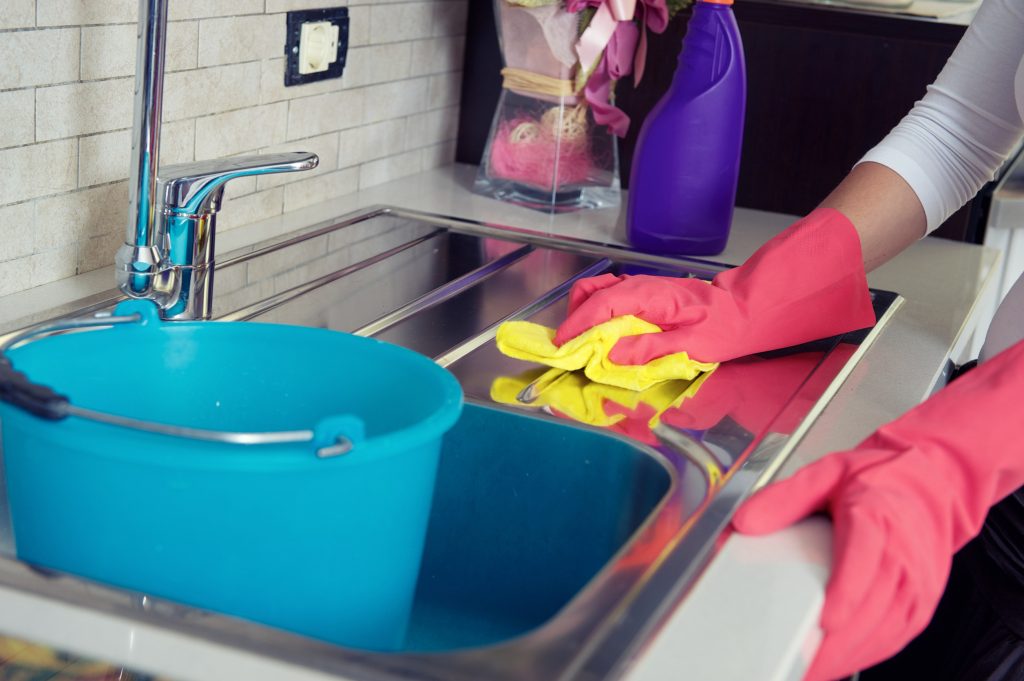
That dark, unassuming cabinet under your kitchen sink often becomes a catch-all for cleaning supplies, extra sponges, and miscellaneous household items. While it seems like a convenient storage spot, its combination of moisture, darkness, and proximity to plumbing makes it a surprisingly hazardous place for many common products. Storing the wrong items here can lead to dangerous chemical reactions, property damage, and serious health risks for your family and pets. Improving your kitchen sink safety involves more than just organization; it requires understanding the potential dangers lurking in that small space. It’s time to rethink this common storage habit and learn what should be relocated for a safer, healthier home.
1. Bleach and Ammonia
Storing bleach and ammonia-based cleaners in the same cabinet is a recipe for disaster. A small, unnoticed leak from both containers could allow the chemicals to mix on the cabinet floor. This mixture creates chloramine gas, a toxic vapor that can cause severe respiratory issues, chest pain, and nausea. Even the ambient fumes in a poorly ventilated space can be irritating and harmful over time. For optimal kitchen sink safety, always store these potent chemicals in separate, well-ventilated locations away from each other.
2. Flammable Liquids
Many common household products, including some polishes, cooking oils, and aerosol cans, are surprisingly flammable. The cabinet under the sink is often near heat-producing appliances like the dishwasher, which can increase the temperature in the enclosed space. An unseen leak or spark from old wiring or a nearby garbage disposal motor could easily ignite these flammable substances. This creates a significant fire hazard right in the heart of your home. Keeping these items far away from potential heat sources is a critical safety measure.
3. Bulk Paper Products
It might seem logical to store extra paper towels or paper bags under the sink, but this is a costly mistake waiting to happen. This area is prone to plumbing leaks, drips, and condensation, which can quickly ruin paper goods. The moisture turns your supply into a soggy, unusable mess and can promote the growth of mold and mildew. This not only wastes money but also introduces harmful mold spores into your kitchen environment. Store paper products in a dry pantry or closet instead.
4. Food of Any Kind
Never store food, including potatoes, onions, or pet food, under the kitchen sink. The dark, often damp environment is an attractive breeding ground for pests like cockroaches and rodents, who can easily find their way in through plumbing gaps. Furthermore, the risk of chemical contamination from leaking cleaning supplies can make any food stored there unsafe for consumption. Protect your family’s health by keeping all edible items in the pantry or refrigerator, far from potential contaminants and pests.
5. Small Electronics
That old blender or handheld vacuum doesn’t belong under the sink, no matter how convenient it seems. Any unforeseen water leak could cause irreparable damage to the appliance’s motor and electronic components. Worse, if an appliance is plugged in nearby and gets wet, it can create a serious risk of electrical shock or a fire. Proper kitchen sink safety dictates that all electronics should be stored in a consistently dry location to prevent water damage and electrical hazards.
6. Pesticides and Herbicides
Chemicals designed to eliminate pests or weeds are highly toxic and should be handled with extreme care. The under-sink cabinet is often easily accessible to curious children and pets, making it a dangerous storage spot for these poisons. Accidental ingestion can have devastating or fatal consequences, a risk that far outweighs any storage convenience. These potent chemicals must be stored in a secure, locked cabinet, preferably in a garage or shed where they are out of reach.
7. Harsh Drain Cleaners
Potent drain cleaners contain highly corrosive chemicals that can eat through skin, clothing, and even plumbing pipes if not used correctly. Storing them under the sink puts them at risk of leaking, which could damage the cabinet structure and other items stored nearby. If a bottle tips over and spills, its corrosive contents pose an immediate chemical burn hazard to anyone who reaches into the cabinet. Keep these aggressive cleaners in a secure, upright position in a well-ventilated utility area.
8. Dishwasher Detergent Pods
To a small child, colorful dishwasher detergent pods can look enticingly like candy. Keeping them in an unlocked cabinet under the sink creates a significant poisoning risk in households with young children. Ingestion of the concentrated detergent can cause severe internal burns and other life-threatening injuries. Always store these pods in their original container on a high shelf or in a cabinet with a childproof lock to prevent a tragic accident.
9. Extra Propane Canisters
Small propane or butane canisters for camping stoves or torches have absolutely no place in your kitchen. These containers of compressed, flammable gas are extremely sensitive to heat and can explode if the temperature rises too high. The proximity to the dishwasher or other heat sources makes the under-sink area a dangerously volatile storage location. Always store these fuel canisters in a cool, well-ventilated space like a garage or outdoor shed, away from living areas.
10. Anything in a Damaged Container
Regularly inspect the items you keep under your sink for any signs of damage, rust, or leaks. A cracked bottle or a rusting aerosol can compromises the container’s integrity and increases the likelihood of a spill. Continuing to store a product in a damaged container is an unnecessary gamble that threatens your property and health. Prioritizing kitchen sink safety means immediately and properly disposing of any product whose packaging is no longer secure, regardless of how much is left.
Reclaim Your Cabinet for Safety
That small space under your sink holds more potential hazards than you might realize. By moving dangerous chemicals, flammable items, and moisture-sensitive products to safer locations, you eliminate a host of hidden risks. A few simple changes can dramatically improve your home’s kitchen sink safety and give you valuable peace of mind. Taking the time to declutter and relocate these items is a small investment in protecting your home and the well-being of your family.
What’s the most surprising item on this list that you currently keep under your sink? Share your thoughts in the comments below!
Read More:
The 7 Most Dangerous Places in Your Home That Are Accidentally Putting Your Family at Risk
Knock, Knock: 8 Warning Signs You Shouldn’t Answer The Door
The post 10 Things You Should Never, Ever Keep Under Your Kitchen Sink appeared first on Budget and the Bees.







